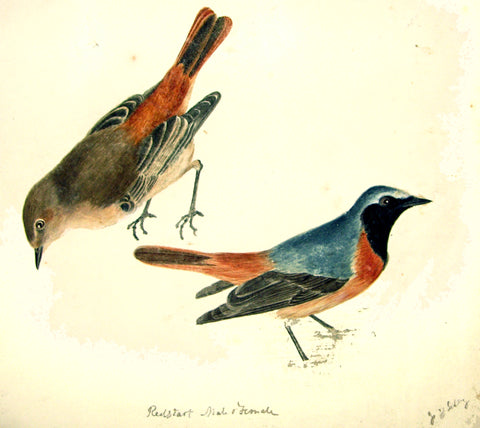
Prideaux John Selby (British, 1788-1867), “Redstart, Male and Female”
Prideaux John Selby (British, 1788-1867)
“Redstart, Male and Female”
Original watercolor prepared for Plate 46 of Illustrations of British Ornithology
Watercolor, gouache, grey and brown washes, pen and black ink on paper
Inscribed lower cneter: Redstart Male and Female
Signed lower right: P.J. Selby.
Paper size: 9 5/8 x 8 7/8 in.
Plate 46. Fig. 3. The male bird. Natural size. General Base of the bill, space between the bill and eyes, cheeks, throat, and upper part of the under side of the neck, black. Forehead white. Head, hind part of the neck and back deep bluish-grey. Breast, rump, and flank reddish-orange; tail the same, except the two middle feathers, which are clove-brown. Middle of the lower part of the belly, and the vent, white; under tail-coverts reddish-orange. Quills greyish- black, the second and sixth feathers being of equal length. Legs and toes black.
Fig. 8. The Female. Natural size. Upper parts yellowish-brown, with a shade of grey upon
the head and back. Breast and flanks pale reddish-orange. Throat reddish-white. Rump and tail reddish-orange, except the two middle feathers; but which are not so bright as in the male bird.
The young males of the year are without the white forehead, and the black upon the throat is intermixed with white feathers, as well as the orange upon the breast. The upper parts are pale red dish- brown, tinged with Grey.”
Considered by many as the English equivalent of Audubon, Prideaux John Selby created some of the most memorable bird images of the nineteenth-century. His contributions to British ornithology were rivaled only by those of John Gould. Yet, his pictures were larger and less purely scientific, exhibiting Selby’s distinctive and charming style. A sense of Selby’s enthusiasm for his subjects is nowhere more palpable than in his engaging original watercolors. Selby executed these delightful images as preparatory models for his landmark printed series, Illustrations of British Ornithology. While the artist’s engraved work is highly desirable to collectors, Selby’s original watercolors rarely become available. This selection of watercolors, moreover, comprises several of his masterpieces. The distinctive birds are depicted in profile, their forms delineated by softly modulated tones of black and gray wash. The setting, if present, is lightly but skillfully painted to not distract from the birds themselves. The skill and delicacy of Selby’s touch, his keen powers of observation, and his artistic sensitivity are conveyed here in a way they are not in his printed work. Several of the drawings are by Selby’s brother-in-law, Robert Mitford, but signed in Selby’s hand.
Born in Northumberland and educated at University College, Oxford, Selby was a landowner and squire with ample time to devote to studying the plant and animal life at his country estate, Twizell House. As a boy, he had studied the habits of local birds, drawn them, and learned how to preserve and set up specimens. Later, Selby became an active member of several British natural history societies and contributed many articles to their journals. Although Selby was interested in botany and produced a History of British Trees in 1842, he is best known for his Illustrations of British Ornithology. Selby’s work was the first attempt to create a set of life-sized illustrations of British birds, remarkable for their naturalism and the delicacy of their execution. The British Ornithology was issued in nineteen parts over thirteen years; the book consisted of 89 plates of land birds and 129 plates of water birds, engraved by William Lizars of Edinburgh, the printer who engraved the first ten plates of Audubon’s Birds of America.
With their rich detail and tonal range, these exquisite watercolors are beautiful works by one of the foremost British bird painters. Furthermore, they represent a singular opportunity to obtain a unique piece of the highest quality by this luminary artist, from an era in British ornithological art that remains unparalleled.
or by email at loricohen@aradergalleries.
We Also Recommend





